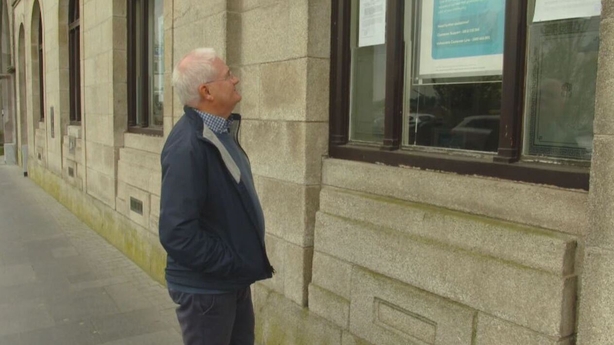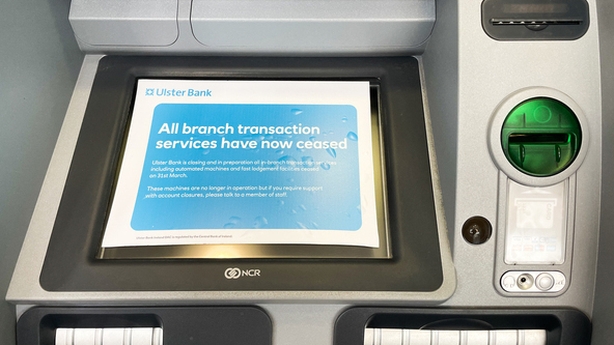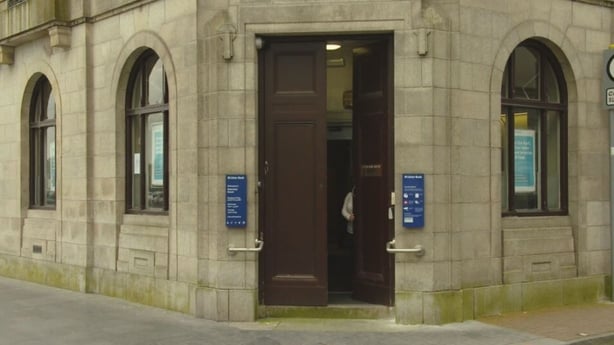On the quays in Waterford, a passing PJ McIntyre stops to look at the Ulster Bank branch, hours before it closes its doors for good.
His family has had a long association with the company. PJ's father worked for it between 1930 and 1975.
His wife was also an employee from 1978 to 1994.
And PJ himself was an Ulster Bank staff member from 1978 to 1990 and then from 2006 to 2015.
"So between my father, my wife and myself we have about 83 or 84 years history working with this bank, which has been operating in Ireland for about 187 years," he said.
"So I think it is a very sad day. It is a sad day for Ireland. It is a sad day for all my former colleagues, I am retired myself now. And it is very sad day for the staff here behind us and staff in all the branches around the country."

In cities, towns and villages across the nation this evening, many other current and former Ulster Bank staff will be reminiscing like this about days gone by, as the remaining branches were shuttered for the final time.
It is all part of the gradual wind-down of the bank ahead of its eventual complete withdrawal from the Republic of Ireland and the handing back of its licence to the Central Bank.
There have been many milestones along the way, since parent NatWest announced in February of 2021 that it was pulling out because a review had found future financial returns would not be acceptable.
But from a customer-facing point of view and in the context of Irish banking history, today is certainly one of the biggest.
It is a big, sad day for the 450 staff who will be losing their jobs as a result of the closures.
Read more: Remaining 63 Ulster Bank branches close permanently
Unlike their 700 colleagues who transferred across with the customers they managed and the 25 branches sold to Permanent TSB and AIB, they are now without a job.
For communities across the Republic, the closure of branches will also be a bitter blow.
Villages like Blessington in Co Wicklow, for example, which is now left with just one AIB bank branch after the exit of Ulster Bank.
That AIB branch doesn’t offer cash services, meaning anyone wanting to carry out such transactions will have to travel many kilometres to do so.
While Palmerstown in Dublin is losing its only bank branch, although arguably customers living in cities are better served with banking facilities than those in more rural towns.

Today’s closures have not come as an overnight surprise.
The bank has been gradually winding down its services, selling assets, stopping new lending, deactivating credit cards and since last year forcibly closing customer accounts where the six months’ notice they had been given had expired.
Ulster Bank did give notice that these branch closures would come several months ago, and three weeks ago ceased offering in-branch transactions, though the branches remained open as support hubs in the interim.
But nonetheless, it is, as Ulster Bank CEO Jane Howard put it in a statement today, a "poignant" moment.
After the lender's branches close today and ATM cease to be accessible, remaining customers will only be able to contact the bank through phone and online channels.
Some services and support will continue to be available there, but of course everything will be focused towards getting accounts closed, customers moved on to other lenders where necessary and the bank wound down.
The lender is keen to emphasise that vulnerable customers and those who need extra support will still be able to get it.
Dedicated phone lines that were put in place to help such customers, or those who care for them are still there and will continue to operate.
And anyone who needs help moving accounts is being urged by the Banking and Payments Federation Ireland and Safeguarding Ireland to ask for it at any of the five retail banks where supports remain in place.
The number of customers still actively using Ulster Bank services is waning though.
Two years ago when it announced its departure, Ulster Bank had around 1.1m customers.
We need your consent to load this rte-player contentWe use rte-player to manage extra content that can set cookies on your device and collect data about your activity. Please review their details and accept them to load the content.Manage Preferences
Around 360,000 had active current accounts and 300,000 deposit accounts, and there were also 70,000 business accounts.
Today the bank says 99% of personal current and deposit accounts are either closed, inactive or with customers who have materially wound down their level of activity in their accounts to five or less transactions.
While 91% of business account holders have either closed their account, reduced transactions to less than five a month or are inactive.
So clearly the number of customers is getting much smaller.
But there is also plenty more work needed behind the scenes, before it disappears altogether, expected to be sometime over the next year or so.
In general Ulster Bank is likely to be happy with how the withdrawal process has gone to date.
Its exit announcement in 2021 was followed quickly by KBC Bank which said it was going to do the same thing.
And as the processes started to get under way, there was much concern both inside and outside the banking sector about the possibility of chaos ensuing.
Customers initially reported long delays in getting appointments in branches of all banks to move or close accounts.
While the Central Bank found there were unacceptable delays on customer service lines across the various lenders.

There was also plenty of anecdotal evidence of people experiencing frustrating difficulties with all the banks around the technical process of moving bill payments and changing where their salaries and social welfare were being paid into.
The situation did shine a light on the inadequacies of the Central Bank switching code, an issue that the Department of Finance’s Retail Banking Review recommended by re-examined.
Reasonably quickly though, all the main banks under the watchful eye of the Central Bank, and the coordination of the Banking and Payments Federation, began to cooperate better.
They all added significant resources to help cope with the extra required customer support and liaised with external stakeholders, including direct debit originators.
Since then the situation has in general appeared from the outside looking in to have settled down.
There is no doubt that the process of switching banks and closing accounts hasn't been plain sailing for everyone.
But in the main, it has been smoother than perhaps might have been anticipated two years ago.
Indeed, perhaps surprisingly, the Financial Services and Pensions Ombudsman recently said that his office had received a relatively small number of complaints related to the process last year.
That process of course is not over though.
Latest Central Bank data shows that at the end of March across both Ulster Bank and KBC there were still 168,000 accounts open, with almost a third of those primary accounts.
And perhaps in some ways the hardest still lies ahead, as solutions are found for the most vulnerable customers, those who have financial difficulties and those who have buried their heads in the sand.
So, while today is undoubtedly a big milestone in Irish banking history, Ulster Bank’s long goodbye continues for now.







